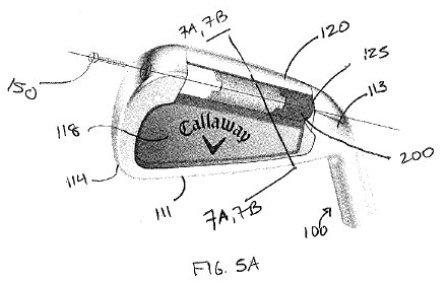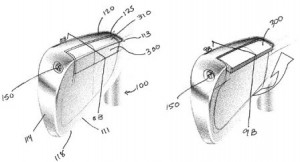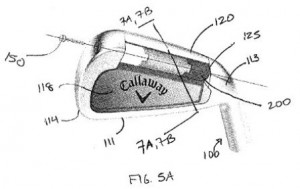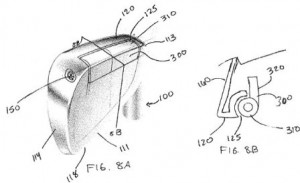Adjustable Irons from Callaway Golf?
The concept of iron adjustability is nothing new, but the major manufacturers are adding their own spin on the concept and seeking patent protection. Recall THIS post questioning who did it better, Acushnet or Bridgestone?
Apparently Callaway also has some interest in adjustable irons, as exhibited by a patent that issued last week as USPN 8777774, titled “adjustable iron-type golf club head.” The patent describes the invention as:
The present invention discloses an iron-type golf club head having features that permit adjustment to the principal moment of inertia angle, the center of gravity location, turf interaction, loft, and overall club forgiveness. In particular, the golf club head includes a rear cavity sized to receive a weight cartridge composed of one or more materials, the adjustment of which changes one or more of the mass properties of the golf club head and also changes the interaction of the golf club head with turf during play. The weight cartridge may comprise one or more high density materials, and may be located in or proximate the sole.
The patent goes on to explain:
2. Description of the Related Art
The prior art discloses various types of golf club heads having preferred moments of inertia characteristics. In particular, U.S. Pat. No. 6,045,455, entitled “Inertially tailored golf club heads,” the disclosure of which is hereby incorporated in its entirety herein, and U.S. Pat. No. 6,186,905, entitled “Methods for designing golf club heads,” the disclosure of which is hereby incorporated in its entirety herein, are both related to methods for designing inertially tailored golf club heads. The prior art does not, however disclose optimized, adjustable irons that permit a user to tailor the moment of inertia or center of gravity characteristics of his or her club.
Furthermore, traditional iron-type golf clubs include faces made of metal materials, and usually the same material as the rest of the iron body. This reduces the amount of discretionary weight available to manufacturers, which they otherwise would be able to use to adjust characteristics of the golf club head like moment of inertia and center of gravity location.
.
.
.
The location of the weight cartridge 20 near the sole portion 12 of the golf club head 10 also preferably is designed to affect the interaction of the golf club head 10 with turf during play. For example, in the preferred embodiment of the present invention, shown in FIGS. 5A-7B, an iron-type golf club head 100 comprises a top rail 111, heel 113, toe 114, face 160, and sole portion 120, as well as a tubular recess 125 in the sole portion that extends into a rear cavity of the golf club head 10 but, in alternative embodiments, may be contained entirely within the sole portion 120. The preferred embodiment also includes a cylindrical weight cartridge 200, which preferably includes three sections: a first end section 202, a middle section 204, and a second end section 206. As shown in FIGS. 6A and 6B, the orientation of the weight cartridge 200 within the recess 125 affects the mass properties of the club iron-type golf club head 100, with the orientation shown in FIG. 6A causing neutral weighting and the orientation shown in FIG. 6B causing draw weighting.
As shown in FIGS. 7A and 7B, the orientation of the weight cartridge 200 also affects the interaction between the golf club head 100 and the turf or ground surface. In the preferred embodiment, the middle section 204 of the weight cartridge has a diameter that is greater than that of the first and second end sections 202, 206, and is slightly offset from the first and second end sections 202, 206 so that the middle section 204 protrudes slightly from one side of the weight cartridge 200. When the protruding part 205 of the middle section 204 faces upward into the body of the golf club head 100, the golf club head has a different loft than when the protruding part of the middle section 204 faces downwards into the turf. In this way, turf interaction can be altered by changing the orientation of the weight cartridge 200, and can further be altered by replacing the weight cartridge 200 with a different weight cartridge 200 having a different shape or turf interaction profile. The weight cartridge 200 can be retained within the recess 125 by any means known to a person skilled in the art, but preferably is removably secured within the recess 125 with at least one screw 150.
Another embodiment of the present invention shown in FIGS. 8A through 9B, also includes a feature that allows a golfer to adjust the turf interaction provided by his or her golf club head 100. In this embodiment, the golf club head 100 has a similar structure to that of the preferred embodiment shown in FIGS. 5A through 7B, but instead of a weight cartridge 200, the golf club head includes an adjustable sole piece 300 having a screw receiving portion 310, which is affixed within the recess 125 of the sole portion 120, and a flange portion 320 that extends away from the screw receiving portion 310. As in the preferred embodiment, the adjustable sole piece 300 can be retained within the recess 125 by any means known to a person skilled in the art, but preferably is removably secured within the recess 125 with at least one screw 150.
As shown in FIGS. 8A through 9B, adjusting the orientation of the flange portion 320 changes the overall width of the sole of the golf club head 100. When in the configuration shown in FIGS. 8A and 8B, and the flange portion 320 is approximately parallel with the face 160, the golf club head 100 has a narrow sole, and much less turf interaction. When the adjustable sole piece 300 is adjusted so that the flange portion 320 is approximately perpendicular to the face 160 as shown in FIGS. 9A and 9B, the sole width is much increased. The flange portion 320 may further include texturing or other features on its outermost surface 325 to further affect the interaction between the golf club head 100 and the turf. In other embodiments, the adjustable sole piece 300 may make up the entirety of the sole of the golf club head 100, such that the golf club head 100 has no sole portion 120 when the adjustable sole piece 300 is removed from the golf club head 100. In these embodiments, the adjustable sole piece 300 is affixed directly to the heel and toe portions 113, 114 of the golf club head 100 and may make contact with the face 160.
That is all good and well, but will we see such an adjustable iron design on the market in the next year, 5 years, 10 years?
Given that only a very small number of golfers would willing to pay a premium for such a design, we aren’t going to see such irons on the market for at least 5 years.
Dave Dawsey – Monitoring Adjustable Golf Club Inventions
PS – If you like what we are doing, please considering helping us out and make your online gear purchases through our Amazon affiliate link. Every little purchase helps us keep the site up and running! Thanks.






